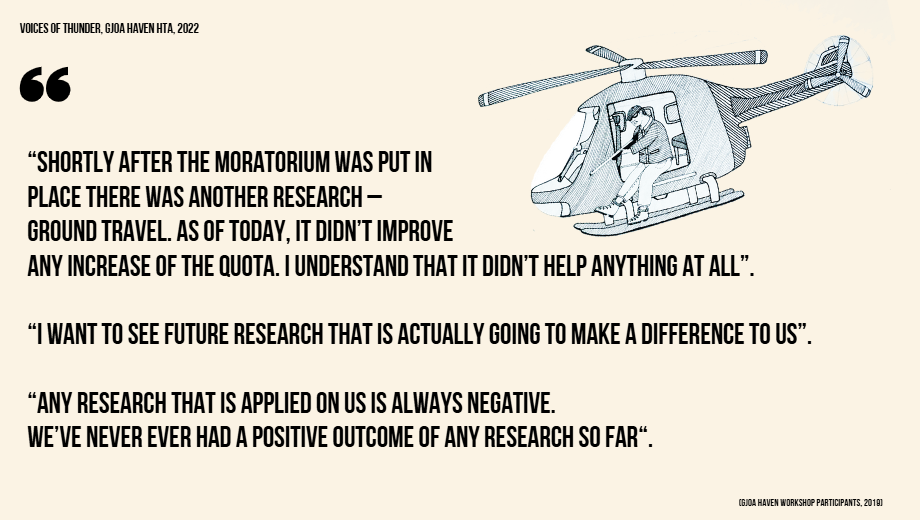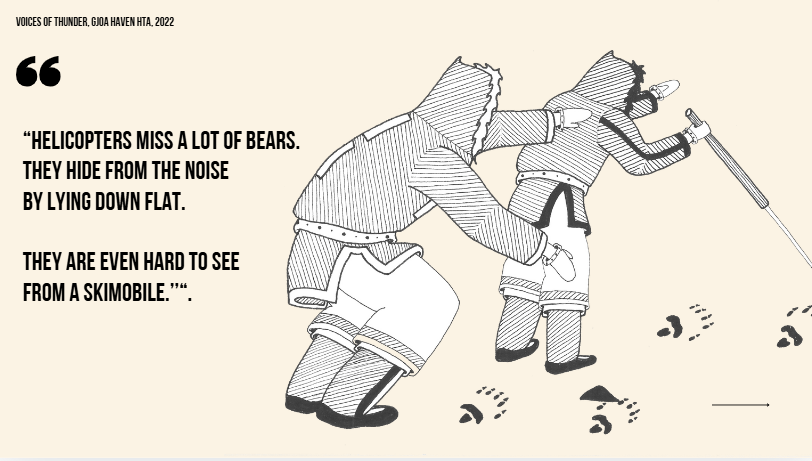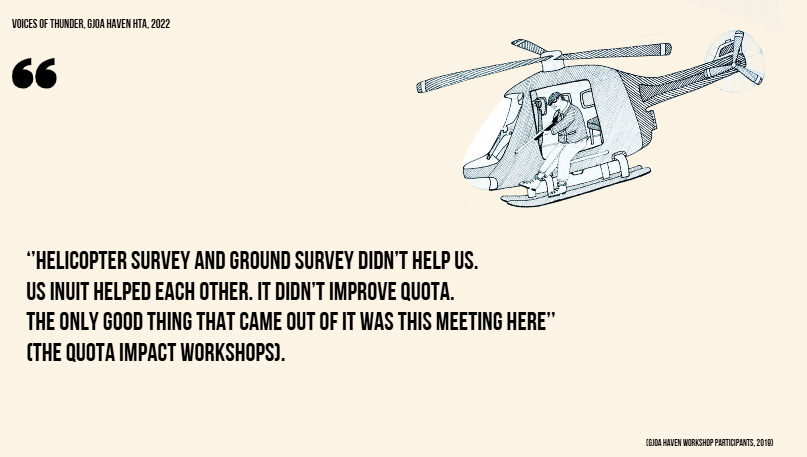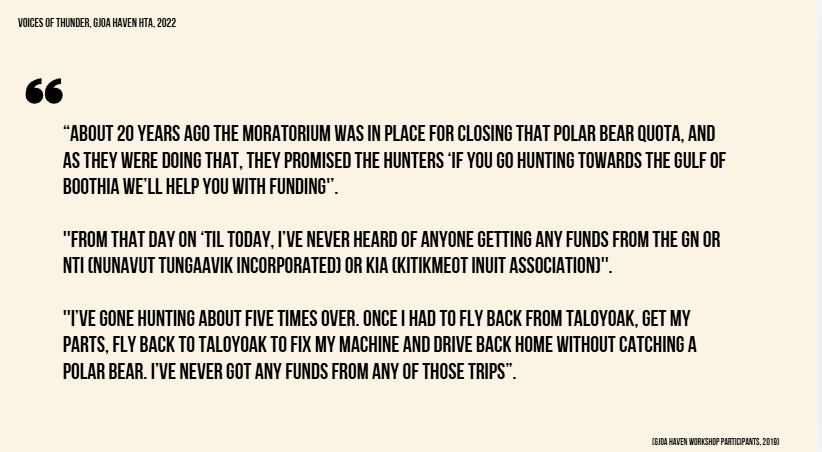Multiple Voices: Difference between revisions
| (3 intermediate revisions by the same user not shown) | |||
| Line 45: | Line 45: | ||
</div> | </div> | ||
<span class="return to-cut-3 link" data-page-title=" | <span class="return to-cut-3 link" data-page-title="Wayfaring_the_BW_project" data-section-id="1" data-encounter-type="return">[[Wayfaring the BW project#Coral Harbour First Trip 2020|Return to Cut 3: Wayfaring the BearWatch project]]</span> | ||
=Voices of Thunder Animated Graphic Documentary= | =Voices of Thunder Animated Graphic Documentary= | ||
| Line 78: | Line 78: | ||
Or, | Or, | ||
'''"Return to Cut 3"''', if you trailed | '''"Return to Cut 3"''', if you trailed off while doing other fieldwork in Gjoa Haven. | ||
</div> | </div> | ||
| Line 87: | Line 87: | ||
<span class="detour to-cut-2 link" data-page-title="Aesthetic_Action" data-section-id="9" data-encounter-type="detour">[[Point of Beginning Animated Graphic Documentary|Detour to Cut 2: Aesthetic Action]]</span> | <span class="detour to-cut-2 link" data-page-title="Aesthetic_Action" data-section-id="9" data-encounter-type="detour">[[Point of Beginning Animated Graphic Documentary|Detour to Cut 2: Aesthetic Action]]</span> | ||
<span class="return to cut 3 link" data-page-title="Wayfaring_the_BW_project" data-section-id="8" data-encounter-type="return">[[Wayfaring the BW project# | <span class="return to cut 3 link" data-page-title="Wayfaring_the_BW_project" data-section-id="8" data-encounter-type="return">[[Wayfaring the BW project#Voices of Thunder Meetings|Return to Cut 3: Gjoa Haven fieldwork 2022]]</span> | ||
=Winds of Change Webpage= | =Winds of Change Webpage= | ||
| Line 292: | Line 292: | ||
Our article, Voices of Thunder: Polar Bear Quota Reduction Impacts in Gjoa Haven, Nunavut - From Purveying Voices to Accepting Testimony, was submitted for peer review at the Arctic Science Journal in January 2025. | Our article, Voices of Thunder: Polar Bear Quota Reduction Impacts in Gjoa Haven, Nunavut - From Purveying Voices to Accepting Testimony, was submitted for peer review at the Arctic Science Journal in January 2025. | ||
[[File:Beyond the cut.png|thumb]] | [[File:Beyond the cut (sm).png|thumb]] | ||
<div class="next_choice">Corresponding cuts 2 and 3, provide additional insights on how aesthetic actions, like the ones shared in this cut, may come to matter as ethical spaces of engagement and how they may open possibilities for ethical processes on the way. | <div class="next_choice">Corresponding cuts 2 and 3, provide additional insights on how aesthetic actions, like the ones shared in this cut, may come to matter as ethical spaces of engagement and how they may open possibilities for ethical processes on the way. | ||
Latest revision as of 13:57, 16 August 2025
Alongside the disruptive forces of Covid-19, we were able to remotely set a course to center Gjoa Haven's Voices of Thunder. We had decided on an academic article, multiple co-created audio/visual outputs, and one-pager communications.
During the remote calls we also navigated the position of the academic scientists when sharing such testimonies of quota reduction impacts. Our conversations included discussions on the challenge of presenting Gjoa Haven’s voices and objectives, without the academic partners speaking for the community.
Testimonial Reading[edit]
For the academic article, I eventually suggested the academic research partners of the BearWatch project to conduct a "testimonial reading". This approach, proposed by Megan Boler[1]suggests for readers or listeners to accept testimony by considering themselves as implicated with the events they accept testimony for. ‘’…one must recognize oneself as implicated in the social forces that create the climate of obstacles the other must confront’’[2]
This approach resonates with guiding principles for reconciliation put forward by the Canadian Truth and Reconciliation Committee (TRC, 2015 p. 113). One of those principles proposes an ‘awareness of the past, acknowledgement of the harm that has been inflicted, atonement for the causes, and action to change behaviour’ (ibid).
Or,
"Keep Going" to trace our other collaborative efforts of sharing Gjoa Haven's "Voices of Thunder", before exploring this testimonial reading.
- ↑ Boler, M. (1997) “The risks of empathy: Interrogating multiculturalism’s gaze,” Cultural Studies, 11(2), pp. 253–273. Available at: https://doi.org/10.1080/09502389700490141.
- ↑ Boler, M. (1997 p.257) “The risks of empathy: Interrogating multiculturalism’s gaze,” Cultural Studies, 11(2), pp. 253–273. Available at: https://doi.org/10.1080/09502389700490141.
Landmark: Multiple Sites of Enunciation
Voices of Thunder Testimonies[edit]
Going forward, this cut will trace the co-creative processes of the Gjoa Haven HTA representatives and BW scientists as worked on, i) Voices of Thunder; an animated motion graphic documentary, ii) Winds of Change; webpage, and iii) Voices of Thunder; an interactive slideshow.
You are invited to engage with these outputs to the degree that feels fitting with your own positionality. Scientists that practice community-based wildlife monitoring in the Canadian Arctic will likely find themselves face decisions that are familiar to their own research contexts. Others, on the other hand, may not have much to gain by conducting a testimonial reading alongside non-Inuit researchers.
Looking back, you see two tracks.
Down the track of cut 1, you can just about (still) see a landmark: Multiple sites of enunciation. Although you can’t really engage with it from here, it reminds you as you keep going that everyone has different places of beginnings, and therefore might travel this path in multiple directions.
You also see a track that may lead you back to Cut 3. It is possible to (re)turn there, and continue your tread alongside other unfoldings of the BearWatch project.
Return to Cut 3: Wayfaring the BearWatch project
Voices of Thunder Animated Graphic Documentary[edit]
Based on the testimonies of 28 different community members, governance documentation and scientific literature, we were able to co-create an animated graphic documentary: Voices of Thunder.
It is narrated by Gjoa Haven community members William Aglukkaq and Tuppittia Qitsualik. Interpretations were done by Jacob Keanik and translations were provided by Tuppittia Qitsualik. Artwork is provided by Danny Aaluk.
Voices of Thunder Inuktitut Syllabics version
Voices of Thunder English version
"Keep Going" to follow the Voices of Thunder, they will lead you to some of the other research outputs.
Or,
Take "Detour" to the film’s synopsis and its poster as it was distributed within the film festival circuit.
Or,
Take a "Detour to Cut 2"; Aesthetic Action, which allows you move alongside the process of film-making within the community.
Or,
"Return to Cut 3", if you trailed off while doing other fieldwork in Gjoa Haven.
Detour: Voices of Thunder "Synopsis"
Detour to Cut 2: Aesthetic Action
Return to Cut 3: Gjoa Haven fieldwork 2022
Winds of Change Webpage[edit]
In addition to the motion graphic animation, we built a “Winds of Change” webpage, The webpage functions as an online advocacy tool and repository for Gjoa Haven’s “Voices of Thunder”, as it also gathers much of the other collected material related to Gjoa Haven’s experiences around polar bears.
This webpage performs the political appeal for recognition as put forward by the HTA board in 2022. It is published in 3 versions: English, Inuktitut, and a Syllabics version.
Voices of Thunder Interactive Slideshow[edit]
During the co-production of the animated graphic documentary, it became clear that in addition to an academic publication, webpage and video production, a third way of presenting the experiences as shared by Gjoa Haven’s community members, might be desirable.
A document that would provide all the same information, arts and experiences that were shared in the animated graphic documentary- but could also afford for a more responsive way of interacting with Gjoa Haven’s testimonies.
A supplemental form of output to the video and webpage, was created in the form of interactive slides, available in three versions; English, Inuktitut, and Inuktitut syllabics. It was added to the Winds of Change webpage.
English Version Slideshow
Inuktitut Version Slideshow
Inuktitut Syllabics Version Slideshow
"Keep Going" to continue tracing our process of testimonial reading.
Alternatively, you can take a short-cut to the current cusp of emergence, a "Detour" straight to the ongoing developments around the Voices of Thunder as they keep unfolding. Doing so will have you miss out on crucial insights to answering my research question however.
Detour to Cut 1: The Cusp of Emergence
Return to Cut 2: Aesthetic Action
Voices of Thunder Testimonial Reading[edit]
You have chosen to follow alongside me, and three non-Indigenous co-PI's of the Bearwatch project as we, i) acknowledge our initial affective responses towards selected testimonies, ii) explore how we may be implicated with the experiences shared by Gjoa Haven community members, and iii) as we make ourselves accountable, as part of a research legacy that has neglected to properly recognize and engage with these experiences before.
Affective Responses[edit]
To refuse passive empathy and take reconciliatory action as non-Indigenous researchers, we must explore our own self-implication. An important part of doing so is to acknowledge our affective responses (including those of guilt and unsettlement) as part of that process[1].
What are your first affective responses to such commentaries on research?
- ↑ Daly, B. (2005) “Taking Whiteness Personally: Learning to Teach Testimonial Reading and Writing in the College Literature Classroom,” Pedagogy, 5(2), pp. 213–246. Available at: https://doi.org/10.1215/15314200-5-2-213.
Implication[edit]
Part of conducting a testimonial reading is to consider oneself as implicated within the larger structures ‘that create the climate of obstacles the other must confront[1]’.
Following Rothberg, we are not by default guilty of the lack of accountability displayed by previous research partners in Gjoa Haven - but we do carry a responsibility to acknowledge and address the structures and institutes that have made, and continue to make it possible for researchers to avoid accountability and ignore community priorities[2].
Or,
Explore how the BearWatch project is entanglement within the larger apparatuses of polar bear harvest quota setting.
- ↑ Boler, M. (1997) p.257 “The risks of empathy: Interrogating multiculturalism’s gaze,” Cultural Studies, 11(2), pp. 253–273. Available at: https://doi.org/10.1080/09502389700490141.
- ↑ Rothberg, M. (2019) The implicated subject. Stanford University Press.
Wrecksite: Nunavut Polar Bear Monitoring and Management
Response-ability[edit]
Co-creating the Voices of Thunder output, with the community as well as conducting this testimonial reading among the non-Indigenous research team has put put our bodies back into the world, and "recognition" into motion as a verb-based practice of "recognizing". It can no longer be displaced elsewhere.
Recognition for Gjoa Gaven’s Voices of Thunder became no longer a discretely determinable goal that could be displaced across people and between spaces, but rather a practice of responding to an-other that we are inseparably entangled with.
To be a response-able research partner is, thus, to enact your ability to respond.
"Keep Going" to stay with the questions of response-ability and accountability.
Or,
Detour: Knowledge Co-production in BearWatch
Relational Accountability[edit]
Within Indigenous (research) paradigms of collective responsibility, and intra-dependency- accountability is often understood in terms of recognizing one’s response-abilities and making oneself accountable to ones more-than-human relations[1][2][3].
Traditional understandings of accountability within western academia as the occasional ‘presenting back’ final outcomes of research to partnering communities, come across as distant and disengaged in comparison.
In the case of Gjoa Haven, many community members expressed feeling like they had to fend for themselves after the considerable cut in polar bear quota. And that the support they were promised, was never delivered.
Visit this "Landmark" insight.
Or,
- ↑ Wilson, S. (2018). Research is ceremony: Indigenous research methods: Fernwood Publishing.
- ↑ McGregor, D. (2009). “Honouring Our Relations: An Anishnaabe Perspective on Environmental Justice.” In Speaking for Ourselves: Environmental Justice in Canada, ed. Julian Agyeman, Peter Cole, Randolph Haluza-Delay, and Pat O’Riley, 27–41. Vancouver: University of British Columbia Press.
- ↑ Kovach, M. (2009). Indigenous methodologies: Characteristics, conversations, and contexts. University of Toronto press.
Landmark: Listening and Witnessing
Another Point of Beginning[edit]
You have reached "Another Point of Beginning". These are not conclusive endings to my research, but rather perform at the cusp of emergence: They are a story so-far. Some of these points mark the end of funding cycles or project activities. Or they mark the limitations and scope of this particular PhD dissertation. Others are trails, and tracks that have faded out, as they remained un-revisited. They however always mark one moment along an ongoing animate line of correspondence between multiple agencies, and they always allow for continuing another cut.
This is where we take account for our journey so far.
This journey is always partial, and so are the insights we have built on our way. You can trace the path you have taken through this Knowledge-Land-Scape by clicking the "trace" bar in the upper right corner of your screen. It will allow you to account for some of the insights that your journey has given you.
The map below shows you the full extent of wayfaring possibilities of the scape.
By choosing to engage with the ongoing conversations and collaborative processes of different "Voices of Thunder" research-creation output, you have been able to not only hear Gjoa Haven community member's experiences, but, perhaps more importantly, also witness your own response-abilities as you threaded your way along the co-creative processes of "accepting testimony".
"Keep going" to explore how the different research output creations have continued their material agencies beyond this cut.Beyond the Cut[edit]
The “Voices of Thunder” Animated Graphic Documentary has been screened in Gjoa Haven, at multiple filmfestivals, and at a regional meeting during which the HTA’s of Gjoa Haven, Taloyoak and Cambridge Bay met with the Kitikmeot Regional Wildlife Board.
A Member of the Legislative Assembly, who resides in Gjoa Haven, leveraged the film, together with the “Winds of Change” website in a letter to the Minister of Environment to call attention to Gjoa Haven testimonies and request ‘a detailed update’ on the ‘department’s work with the Gjoa Haven Hunters and Trappers Association to manage this subpopulation’.
Our article, Voices of Thunder: Polar Bear Quota Reduction Impacts in Gjoa Haven, Nunavut - From Purveying Voices to Accepting Testimony, was submitted for peer review at the Arctic Science Journal in January 2025.
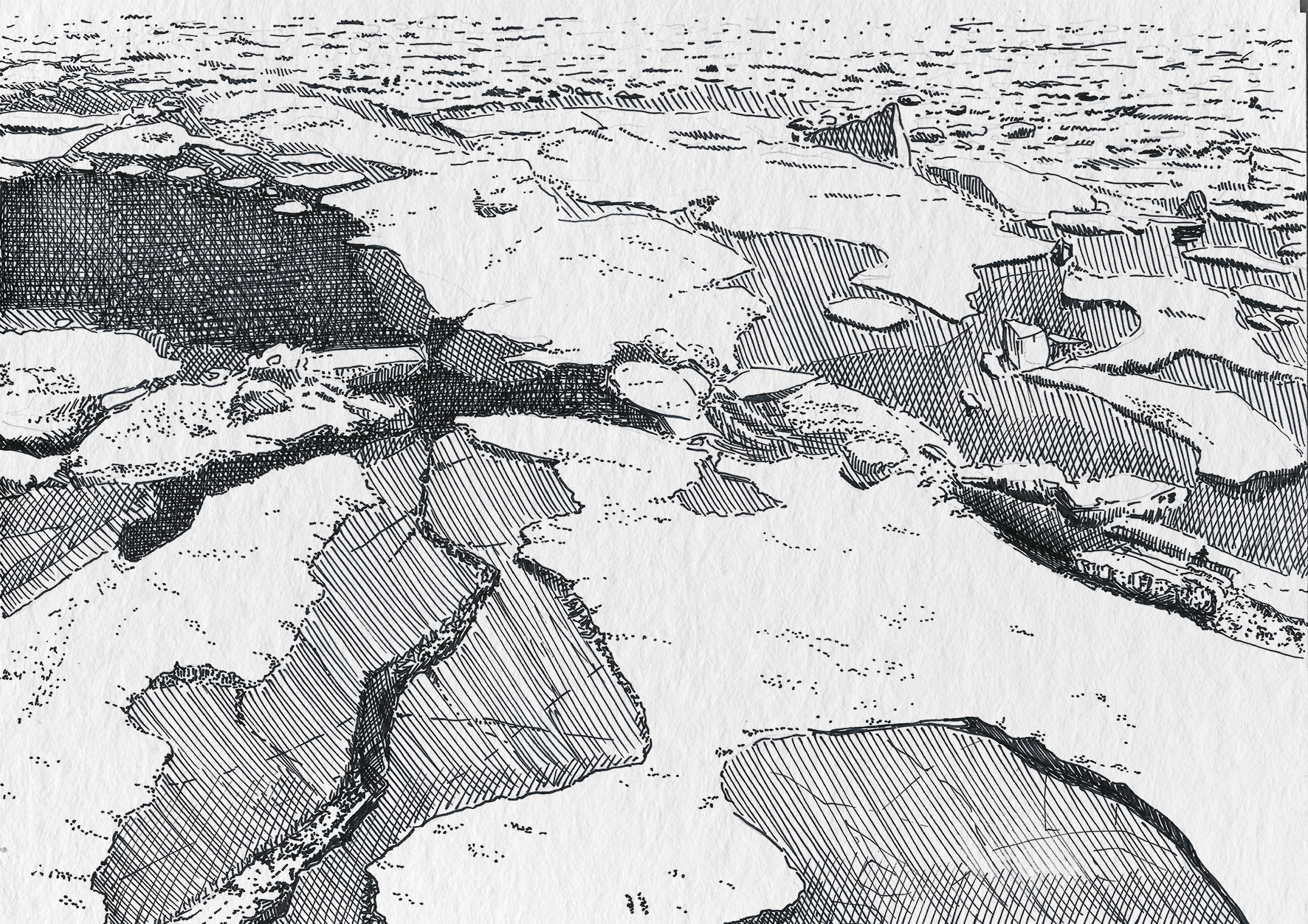
"Detour to Cut 2" to understand more about wayfaring as a process of ethical engagement.
Or,
"Detour to Cut 3" to understand more about how aesthetic action like co-creative film making may co-constitute ethical space.Detour to Cut 2: Aesthetic Action point of Beginning
Detour to Cut 3: Wayfaring the BW project Point of Beginning

